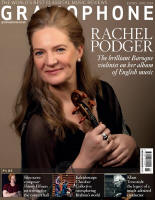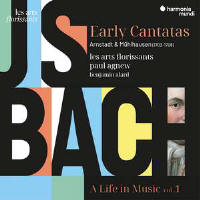Texte paru dans: / Appeared in:
|
|
|
|
|
|
I hail the advent of a new miniseries from Paul Agnew and Les Arts Florissants, having already found their previous surveys of Monteverdi and Gesualdo quite brilliant. This is also a confident entry into a strong market for what Agnew calls Bach’s ‘extraordinary and deeply uncompromising music’. Susan McClary’s note is a superb guide for all audiences. Three of Bach’s early cantatas are presented here, opening with No 4, Christ lag in Todesbanden, followed with the setting by Johann Kuhnau (1660-1722). In between the cantatas are organ works, including chorale arrangements, played by Benjamin Alard in Saint-Vaast, Béthune. In terms of forces, Les Arts Florissants follow notes for a performance in Mühlhausen using four solo singers and four chorus voices – concertists and ripienists.
In Cantata No 4, after a pleasingly sombre Sinfonia, Bach’s opening chorale variation is alarmingly fast, with some rather manic trills in the upper voice. The duet ‘Den Tod niemand zwingen kunnt’, howewer, is immaculate and glassy-toned as sung by Miriam Allen and Thomas Hobbs but the gapped chorale for solo tenor, ‘Jesus Christus, Gottes Sohn’, fails to sparkle. Compared to Andrew Parrott’s dazzling solo-violin version (7/94), anyone performing with unison violins feels too careful for me. The sumptuous antique lament for bass is sung with spacious wonderment by Edward Grint; I don’t normally like it so slow but it’s vivid and pictorial, and just gorgeous in this performance. What a shame the final chorus also feels rushed. My favourite of the organ works is also Christ lag in Todesbanden, BWV718. Alard plays with flair and his registrations showcase a Munrowesque sense of joyful discovery – the perfect way to follow the brilliance of Bach’s vocal cantata. Kuhnau’s cantata is performed with vibrant energy, particularly the rhythmic compulsion of the galloping-horse-style accompaniment in the opening chorale, and the instrumental ritornellos. But again, the last chorus, ‘So feiern wir das hohe Fest’, is rather frenetic.
In Cantata No 150, Nach dir, Herr, verlanget mich, I find the opening lament perfectly judged and in the chorus ‘Nach dir, Herr’ the singers find a madrigalian closeness that is, I suspect, the intention of this project; it makes an interesting comparison to the ‘emotional restraint’ of Vox Luminis (Alpha, 2/17). The opening of Cantata No 106, Gottes Zeit ist die allerbeste Zeit (the Actus tragicus), is less sepia-tinged and more heart-throbbing than I expected, not to be missed. Listen also to the animation of the line of the chorus ‘In ihm leben, weben und sind wir, / Solange er will’ (‘In him we live, and move, and have our being, / For as long as he wishes’) – Les Arts Florissants at their best. Finally, I adored the exposed delicacy of Maarten Engeltjes’s alto aria ‘In deine Hände’ with its gentle organ accompaniment. It’s up close and personal with a hint of fragility. Quite arresting.
These are beautiful, text-centred performances, and while I find several movements too fast for my taste, they are always engaging. There are some extraordinarily good solos throughout, and I keenly anticipate the next volume. |
|




